初探 performance – 监控网页与程序性能
使用 window.performance 提供了一组精确的数据,经过简单的计算就能得出一些网页性能数据。
配合上报一些客户端浏览器的设备类型等数据,就可以实现简单的统计啦!
额,先看下兼容性如何: http://caniuse.com/#feat=nav-timing
这篇文章中 Demo 的运行环境为最新的 Chrome 的控制台,如果你用的是其他浏览器,自查兼容性哈~
先来看看在 Chrome 浏览器控制台中执行 window.performance 会出现什么:
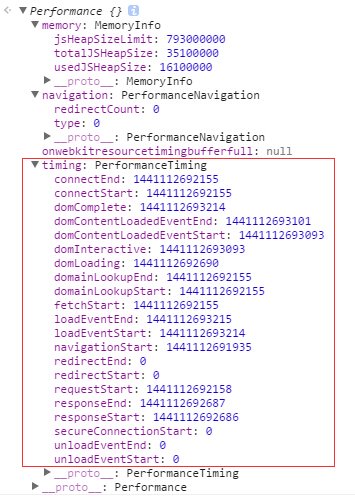
简单解释下 performance 中的属性:
先看下一个请求发出的整个过程中,各种环节的时间顺序:

// 获取 performance 数据
var performance = {
// memory 是非标准属性,只在 Chrome 有
// 财富问题:我有多少内存
memory: {
usedJSHeapSize: 16100000, // JS 对象(包括V8引擎内部对象)占用的内存,一定小于 totalJSHeapSize
totalJSHeapSize: 35100000, // 可使用的内存
jsHeapSizeLimit: 793000000 // 内存大小限制
},
// 哲学问题:我从哪里来?
navigation: {
redirectCount: 0, // 如果有重定向的话,页面通过几次重定向跳转而来
type: 0 // 0 即 TYPE_NAVIGATENEXT 正常进入的页面(非刷新、非重定向等)
// 1 即 TYPE_RELOAD 通过 window.location.reload() 刷新的页面
// 2 即 TYPE_BACK_FORWARD 通过浏览器的前进后退按钮进入的页面(历史记录)
// 255 即 TYPE_UNDEFINED 非以上方式进入的页面
},
timing: {
// 在同一个浏览器上下文中,前一个网页(与当前页面不一定同域)unload 的时间戳,如果无前一个网页 unload ,则与 fetchStart 值相等
navigationStart: 1441112691935,
// 前一个网页(与当前页面同域)unload 的时间戳,如果无前一个网页 unload 或者前一个网页与当前页面不同域,则值为 0
unloadEventStart: 0,
// 和 unloadEventStart 相对应,返回前一个网页 unload 事件绑定的回调函数执行完毕的时间戳
unloadEventEnd: 0,
// 第一个 HTTP 重定向发生时的时间。有跳转且是同域名内的重定向才算,否则值为 0
redirectStart: 0,
// 最后一个 HTTP 重定向完成时的时间。有跳转且是同域名内部的重定向才算,否则值为 0
redirectEnd: 0,
// 浏览器准备好使用 HTTP 请求抓取文档的时间,这发生在检查本地缓存之前
fetchStart: 1441112692155,
// DNS 域名查询开始的时间,如果使用了本地缓存(即无 DNS 查询)或持久连接,则与 fetchStart 值相等
domainLookupStart: 1441112692155,
// DNS 域名查询完成的时间,如果使用了本地缓存(即无 DNS 查询)或持久连接,则与 fetchStart 值相等
domainLookupEnd: 1441112692155,
// HTTP(TCP) 开始建立连接的时间,如果是持久连接,则与 fetchStart 值相等
// 注意如果在传输层发生了错误且重新建立连接,则这里显示的是新建立的连接开始的时间
connectStart: 1441112692155,
// HTTP(TCP) 完成建立连接的时间(完成握手),如果是持久连接,则与 fetchStart 值相等
// 注意如果在传输层发生了错误且重新建立连接,则这里显示的是新建立的连接完成的时间
// 注意这里握手结束,包括安全连接建立完成、SOCKS 授权通过
connectEnd: 1441112692155,
// HTTPS 连接开始的时间,如果不是安全连接,则值为 0
secureConnectionStart: 0,
// HTTP 请求读取真实文档开始的时间(完成建立连接),包括从本地读取缓存
// 连接错误重连时,这里显示的也是新建立连接的时间
requestStart: 1441112692158,
// HTTP 开始接收响应的时间(获取到第一个字节),包括从本地读取缓存
responseStart: 1441112692686,
// HTTP 响应全部接收完成的时间(获取到最后一个字节),包括从本地读取缓存
responseEnd: 1441112692687,
// 开始解析渲染 DOM 树的时间,此时 Document.readyState 变为 loading,并将抛出 readystatechange 相关事件
domLoading: 1441112692690,
// 完成解析 DOM 树的时间,Document.readyState 变为 interactive,并将抛出 readystatechange 相关事件
// 注意只是 DOM 树解析完成,这时候并没有开始加载网页内的资源
domInteractive: 1441112693093,
// DOM 解析完成后,网页内资源加载开始的时间
// 在 DOMContentLoaded 事件抛出前发生
domContentLoadedEventStart: 1441112693093,
// DOM 解析完成后,网页内资源加载完成的时间(如 JS 脚本加载执行完毕)
domContentLoadedEventEnd: 1441112693101,
// DOM 树解析完成,且资源也准备就绪的时间,Document.readyState 变为 complete,并将抛出 readystatechange 相关事件
domComplete: 1441112693214,
// load 事件发送给文档,也即 load 回调函数开始执行的时间
// 注意如果没有绑定 load 事件,值为 0
loadEventStart: 1441112693214,
// load 事件的回调函数执行完毕的时间
loadEventEnd: 1441112693215
// 字母顺序
// connectEnd: 1441112692155,
// connectStart: 1441112692155,
// domComplete: 1441112693214,
// domContentLoadedEventEnd: 1441112693101,
// domContentLoadedEventStart: 1441112693093,
// domInteractive: 1441112693093,
// domLoading: 1441112692690,
// domainLookupEnd: 1441112692155,
// domainLookupStart: 1441112692155,
// fetchStart: 1441112692155,
// loadEventEnd: 1441112693215,
// loadEventStart: 1441112693214,
// navigationStart: 1441112691935,
// redirectEnd: 0,
// redirectStart: 0,
// requestStart: 1441112692158,
// responseEnd: 1441112692687,
// responseStart: 1441112692686,
// secureConnectionStart: 0,
// unloadEventEnd: 0,
// unloadEventStart: 0
}
};
具体的含义都在注释里说明了,接下来我们看下能用这些数据做什么?
使用 performance.timing 信息简单计算出网页性能数据
在注释中,我用【重要】标注了我个人认为比较有用的数据,用【原因】标注了为啥要重点关注这个数据
// 计算加载时间
function getPerformanceTiming () {
var performance = window.performance;
if (!performance) {
// 当前浏览器不支持
console.log('你的浏览器不支持 performance 接口');
return;
}
var t = performance.timing;
var times = {};
//【重要】页面加载完成的时间
//【原因】这几乎代表了用户等待页面可用的时间
times.loadPage = t.loadEventEnd - t.navigationStart;
//【重要】解析 DOM 树结构的时间
//【原因】反省下你的 DOM 树嵌套是不是太多了!
times.domReady = t.domComplete - t.responseEnd;
//【重要】重定向的时间
//【原因】拒绝重定向!比如,http://example.com/ 就不该写成 http://example.com
times.redirect = t.redirectEnd - t.redirectStart;
//【重要】DNS 查询时间
//【原因】DNS 预加载做了么?页面内是不是使用了太多不同的域名导致域名查询的时间太长?
// 可使用 HTML5 Prefetch 预查询 DNS ,见:[HTML5 prefetch](http://segmentfault.com/a/1190000000633364)
times.lookupDomain = t.domainLookupEnd - t.domainLookupStart;
//【重要】读取页面第一个字节的时间
//【原因】这可以理解为用户拿到你的资源占用的时间,加异地机房了么,加CDN 处理了么?加带宽了么?加 CPU 运算速度了么?
// TTFB 即 Time To First Byte 的意思
// 维基百科:https://en.wikipedia.org/wiki/Time_To_First_Byte
times.ttfb = t.responseStart - t.navigationStart;
//【重要】内容加载完成的时间
//【原因】页面内容经过 gzip 压缩了么,静态资源 css/js 等压缩了么?
times.request = t.responseEnd - t.requestStart;
//【重要】执行 onload 回调函数的时间
//【原因】是否太多不必要的操作都放到 onload 回调函数里执行了,考虑过延迟加载、按需加载的策略么?
times.loadEvent = t.loadEventEnd - t.loadEventStart;
// DNS 缓存时间
times.appcache = t.domainLookupStart - t.fetchStart;
// 卸载页面的时间
times.unloadEvent = t.unloadEventEnd - t.unloadEventStart;
// TCP 建立连接完成握手的时间
times.connect = t.connectEnd - t.connectStart;
return times;
}
使用performance.getEntries() 获取所有资源请求的时间数据
这个函数返回的将是一个数组,包含了页面中所有的 HTTP 请求,这里拿第一个请求 window.performance.getEntries()[0] 举例。 注意 HTTP 请求有可能命中本地缓存,所以请求响应的间隔将非常短 可以看到,与 performance.timing 对比: 没有与 DOM 相关的属性:
-
navigationStart
-
unloadEventStart
-
unloadEventEnd
-
domLoading
-
domInteractive
-
domContentLoadedEventStart
-
domContentLoadedEventEnd
-
domComplete
-
loadEventStart
-
loadEventEnd
新增属性:
-
name
-
entryType
-
initiatorType
-
duration
与 window.performance.timing 中包含的属性就不再介绍了:
var entry = {
// 资源名称,也是资源的绝对路径
name: "http://cdn.alloyteam.com/wp-content/themes/alloyteam/style.css",
// 资源类型
entryType: "resource",
// 谁发起的请求
initiatorType: "link", // link 即 <link> 标签
// script 即 <script>
// redirect 即重定向
// 加载时间
duration: 18.13399999809917,
redirectStart: 0,
redirectEnd: 0,
fetchStart: 424.57699999795295,
domainLookupStart: 0,
domainLookupEnd: 0,
connectStart: 0,
connectEnd: 0,
secureConnectionStart: 0,
requestStart: 0,
responseStart: 0,
responseEnd: 442.7109999960521,
startTime: 424.57699999795295
};
可以像 getPerformanceTiming 获取网页的时间一样,获取某个资源的时间:
// 计算加载时间
function getEntryTiming (entry) {
var t = entry;
var times = {};
// 重定向的时间
times.redirect = t.redirectEnd - t.redirectStart;
// DNS 查询时间
times.lookupDomain = t.domainLookupEnd - t.domainLookupStart;
// 内容加载完成的时间
times.request = t.responseEnd - t.requestStart;
// TCP 建立连接完成握手的时间
times.connect = t.connectEnd - t.connectStart;
// 挂载 entry 返回
times.name = entry.name;
times.entryType = entry.entryType;
times.initiatorType = entry.initiatorType;
times.duration = entry.duration;
return times;
}
// test
// var entries = window.performance.getEntries();
// entries.forEach(function (entry) {
// var times = getEntryTiming(entry);
// console.log(times);
// });
使用 performance.now() 精确计算程序执行时间
performance.now() 与 Date.now() 不同的是,返回了以微秒(百万分之一秒)为单位的时间,更加精准。
并且与 Date.now() 会受系统程序执行阻塞的影响不同,performance.now() 的时间是以恒定速率递增的,不受系统时间的影响(系统时间可被人为或软件调整)。
注意 Date.now() 输出的是 UNIX 时间,即距离 1970 的时间,而 performance.now() 输出的是相对于 performance.timing.navigationStart(页面初始化) 的时间。
使用 Date.now() 的差值并非绝对精确,因为计算时间时受系统限制(可能阻塞)。但使用 performance.now() 的差值,并不影响我们计算程序执行的精确时间。
// 计算程序执行的精确时间
function getFunctionTimeWithDate (func) {
var timeStart = Data.now();
// 执行开始
func();
// 执行结束
var timeEnd = Data.now();
// 返回执行时间
return (timeEnd - timeStart);
}
function getFunctionTimeWithPerformance (func) {
var timeStart = window.performance.now();
// 执行开始
func();
// 执行结束
var timeEnd = window.performance.now();
// 返回执行时间
return (timeEnd - timeStart);
}
使用 performance.mark() 也可以精确计算程序执行时间
使用 performance.mark() 标记各种时间戳(就像在地图上打点),保存为各种测量值(测量地图上的点之间的距离),便可以批量地分析这些数据了。
直接上示例代码看注释便明白:
function randomFunc (n) {
if (!n) {
// 生成一个随机数
n = ~~(Math.random() * 10000);
}
var nameStart = 'markStart' + n;
var nameEnd = 'markEnd' + n;
// 函数执行前做个标记
window.performance.mark(nameStart);
for (var i = 0; i < n; i++) {
// do nothing
}
// 函数执行后再做个标记
window.performance.mark(nameEnd);
// 然后测量这个两个标记间的时间距离,并保存起来
var name = 'measureRandomFunc' + n;
window.performance.measure(name, nameStart, nameEnd);
}
// 执行三次看看
randomFunc();
randomFunc();
// 指定一个名字
randomFunc(888);
// 看下保存起来的标记 mark
var marks = window.performance.getEntriesByType('mark');
console.log(marks);
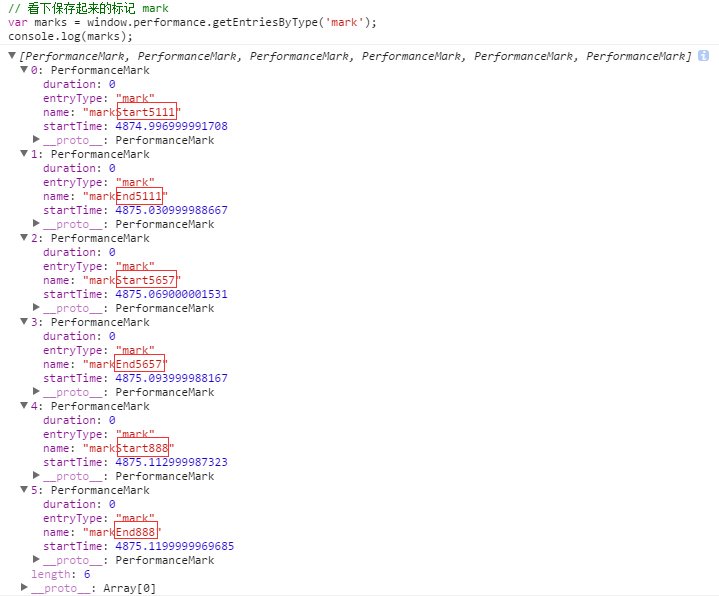
// 看下保存起来的测量 measure
var measure = window.performance.getEntriesByType('measure');
console.log(measure);
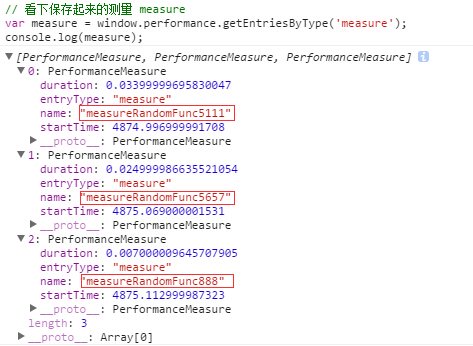
// 看下我们自定义的测量
var entries = window.performance.getEntriesByName('measureRandomFunc888');
console.log(entries);
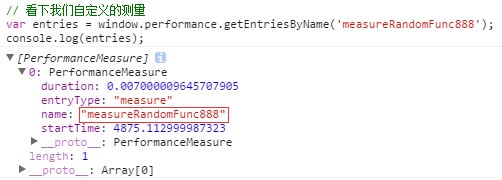
可以看到,for 循环 measureRandomFunc888 的时候
结束时间为: 4875.1199999969685
开始时间为:4875.112999987323
执行时间为:4875.1199999969685 – 4875.112999987323 = 0.00700000964
标记和测量用完了可以清除掉:
// 清除指定标记
window.performance.clearMarks('markStart888');
// 清除所有标记
window.performance.clearMarks();
// 清除指定测量
window.performance.clearMeasures('measureRandomFunc');
// 清除所有测量
window.performance.clearMeasures();
当然 performance.mark() 只是提供了一些简便的测量方式,比如之前我们测量 domReady 是这么测的:
// 计算 domReady 时间 var t = performance.timing var domReadyTime = t.domComplete - t.responseEnd; console.log(domReadyTime)
其实就可以写成:
window.performance.measure('domReady','responseEnd' , 'domComplete');
var domReadyMeasure = window.performance.getEntriesByName('domReady');
console.log(domReadyMeasure);
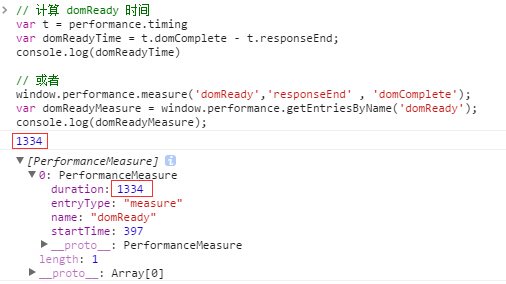
抛砖引玉:performance 数据能干啥用?
熟悉 Chrome 开发者工具的朋友应该知道:在开发环境下,其实我们自己打开 Chrome 的开发者工具,切换到网络面板,就能很详细的看到网页性能相关的数据。但当我们需要统计分析用户打开我们网页时的性能如何时,我们将 performance 原始信息或通过简单计算后的信息(如上面写到的 getPerformanceTiming() 和 getEntryTiming()) 上传到服务器,配合其他信息(如 HTTP 请求头信息),就完美啦~